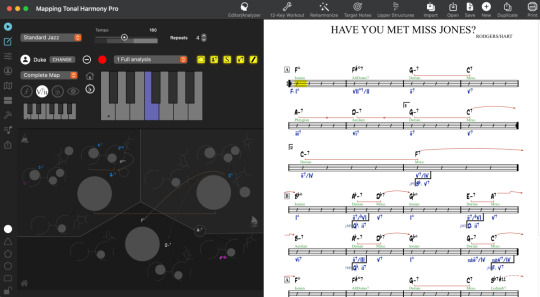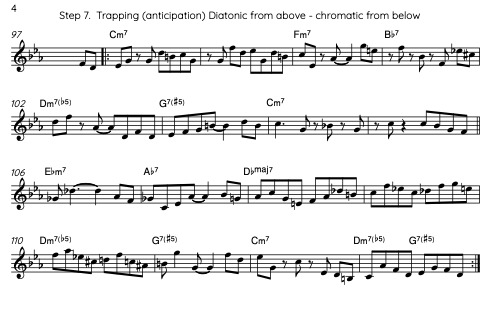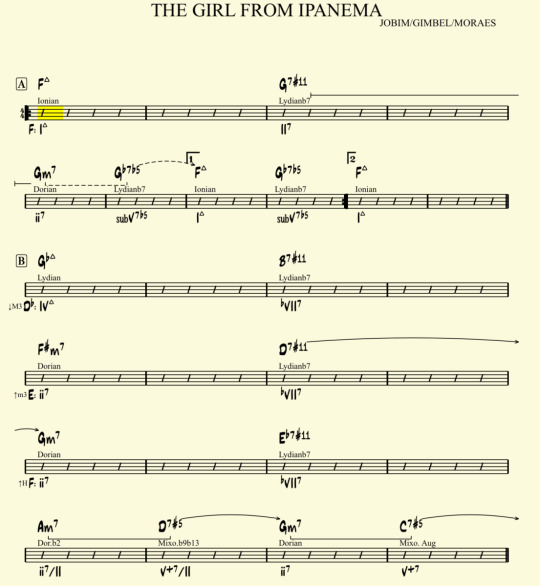Text
How To Play A Piano Montuno on Any Song
Playing piano montunos can transform any song, giving it that infectious Latin groove that makes everyone want to move. Today, we’ll take a jazz standard like “Satin Doll” and turn it into a piano montuno. By the end of this lesson, you’ll know how to create a montuno pattern from any chord progression and apply these concepts to any montuno pattern you want. Step 1: Choose Your Montuno…

View On WordPress
0 notes
Text
Musical IQ Test: What's Your Musical IQ?
Scan or click on the image (or here) to take the test About the mDecks Musical IQ Test In this test we will evaluate your abilities in 10 essential music topics:Meter • Timing • Shuffle vs. Even • Beat Perception • Tempo • Tempo Variation • Melody • Range • In-Tune • Harmony You don’t need to know anything about music or music theory. Anyone can take this test and have a blast! Remember, this…

View On WordPress
1 note
·
View note
Text
Jazz Harmonic Analysis using Mapping Tonal Harmony Pro 10
In this latest version of Mapping Tonal Harmony Pro, we’ve expanded the arrows and brackets analysis to include several new symbols that highlight some of the most commonly encountered harmonic progressions and cadences in jazz tunes, addressing some of the omissions from previous versions. These new arrows and brackets will undoubtedly enhance the analysis, providing a more comprehensive…

View On WordPress
0 notes
Text
A Step-by-Step Guide to Playing Piano Montuno
IntroductionUnlock the rhythmic magic of Latin piano with our comprehensive guide to mastering the Montuno style. In this blog post, we’ll break down an 8-step exercise based on the iconic piano arrangement from Gloria Estefan’s “Conga.” Whether you’re a seasoned pianist or a beginner looking to delve into the world of Latin grooves, this step-by-step breakdown will help you understand the…

View On WordPress
0 notes
Text
The Dorian Scale for Jazz Improvisation
Understanding the Dorian Scale Dorian is the 2nd mode of the major scale. So if we start any major scale on the 2nd degree we get a dorian scale. Step 1 – We are going to play the major scale and then the related dorian scale. A useful variation of this step is to understand where the half-steps are in the dorian scale and then play all dorian scales without considering the related major…

View On WordPress
3 notes
·
View notes
Text
The Major Scale (Ionian) for Jazz Improvisation
The Major Scale (Ionian) The major scale serves as our “source scale,” the point of reference for its related modes. We will delve into the intricacies of this scale, explore its unique properties, and discover its role in improvisational music. The Concept of Source Scales In the realm of musical modes, the Ionian scale takes center stage as the most familiar and frequently employed scale. We…

View On WordPress
2 notes
·
View notes
Text
Bebop Rhythmic Words 1&2: Unleashing Jazz Improvisation through Rhythm. Jazz Piano Tutorial
Introduction: In the world of jazz improvisation, we often emphasize the importance of choosing the right notes over chord changes. However, today we’re going to shift our focus to another crucial aspect of improvisation: rhythm. In this video, we’ll explore the concept of using rhythmic words to guide our bebop improvisation. By incorporating these rhythmic phrases into our playing, we can…

View On WordPress
2 notes
·
View notes
Text
Jazz Practice: How To Create 12-Key Workouts To Practice In Mapping Tonal Harmony Pro 9 iOS. Music App Tutorial.
If you want to practice playing lines over different progressions using a backing track, then look no further than Mapping Tonal Harmony Pro. Let me show you how to create a backing track with consecutive 2-5’s in all keys in less than a minute. I hope that was helpful. Remember, Mapping Tonal Harmony Pro is available on mDecks.com and the AppStore.

View On WordPress
1 note
·
View note
Text
Blues Bossa: A 7-Step Exercise To Master Improvisation Over Jazz Tunes
Are you a jazz musician looking to improve your improvisation skills and develop your improvisation techniques? If so, learning “Blue Bossa” is a great place to start. In this blog post, we’ll take you through a 7-step exercise that will help you achieve these goals. This exercise is the same we used on our “Charlie Parker’s Confirmation” lesson. We’ve created an entire video with slow and fast…

View On WordPress
1 note
·
View note
Text
Jazz Piano for Beginners: Play "All Of You" with Rootless Chords. Tutorial
Jazz pianists often use rootless voicings to create a more open and modern sound. These voicings allow for greater flexibility in the left hand, while the right hand can play the melody or improvisation. In this tutorial, we’ll show you how to play “All Of You” using rootless voicings, and how to apply the same techniques to any other jazz standard. What you’ll learn in this tutorial First,…

View On WordPress
#jazz piano book#jazz piano course#jazz piano lessons#jazz piano method#piano voicings#rootless voicings
0 notes
Text
Mastering 7sus4 Chords like Bill Evans - “I Do It For Your Love” Intro - Jazz Piano Transcription
One of the most iconic piano intros in the history of jazz is Bill Evans’ intro in “I Do It For Your Love” from his album Affinity. The chords he plays in this intro are so unique and captivating that they leave listeners wondering where they came from and how to create something similar. In this video, we will dive deep into the concept of 7sus4 chords, specifically as Bill Evans used them in…

View On WordPress
#Bill Evans transcription#Bill Evans voicings#chords#jazz analysis#jazz piano chords#jazz piano lessons
0 notes
Text
The Ultimate Guide to Pentatonic Voicings for Jazz Pianists: An Interactive Course
Introduction Pentatonic voicings are a valuable tool for jazz pianists and arrangers, as demonstrated by masters such as McCoy Tyner, Chick Corea, and Herbie Hancock. They provide a fresh perspective on voicings and can add depth and interest to your playing. In this interactive PDF course, Pentatonic Voicings by mDecks Music, you’ll learn how to build and practice these essential voicings, and…

View On WordPress
#backing tracks#Interactive PDF#jazz chords#jazz piano course#jazz theory#music education#Music practice#Pentatonic voicings#Piano arrangements#Piano comping#Piano exercises#piano lessons#piano voicings#Quartal music
2 notes
·
View notes
Text
7-Step Exercise to Improve Your Bebop Skills: Learning Charlie Parker's "Confirmation"
Are you a jazz musician looking to improve your improvisation skills and develop your bebop techniques? If so, learning Charlie Parker’s “Confirmation” is a great place to start. In this blog post, we’ll take you through a 7-step exercise that will help you achieve these goals. We’ve created an entire video with slow and fast versions of each step so you can play along. We’ve also included two…

View On WordPress
#7-step exercise#Bebop techniques#Broken chords#Charlie parker#Chromatic approach#confirmation#Enclosures#Improvisation skills#Jazz education#jazz improvisation#Jazz musicianship#Musical practice#target notes
0 notes
Text
Best Online Jazz Piano Lessons in 2023
Learning jazz piano can be a daunting task, but with the right guidance and resources, it can be an incredibly rewarding experience. While traditional jazz piano lessons with a private instructor can be helpful, they can also be expensive and time-consuming. Fortunately, there are now many excellent online jazz piano lesson programs available that offer the convenience and flexibility that many…

View On WordPress
#best piano lessons#jazz improvisation#jazz piano courses#jazz piano lessons#jazz piano online#jazz piano online courses#jazz piano teacher#learn music#music education#music theory#YouTube piano lessons
0 notes
Text
Learning Jazz Harmony the Berklee Way: Deconstructing ‘Misty’ – Part 2
Introduction: In this lesson, we will be discussing the harmony of the jazz standard “Misty” and applying some new techniques to “There Will Never Be Another You”. This post is a follow-up to a previous video by mDecks Music, so make sure to watch Part One first if you haven’t already. Learning Jazz Harmony the Berklee Way: Deconstructing ‘Misty’ – Part 1 We will cover the 2-5-1 progression and…

View On WordPress
#Berklee harmony#jazz harmony#music education#music theory#There Will Never Be Another You#tonal harmony
1 note
·
View note
Text
Learning Jazz Harmony the Berklee Way: Deconstructing 'Misty' - Part 1
If you’re a songwriter or a musician, you may have come across the term “harmony” before. But do you know what it means? Harmony is the simultaneous sounding of two or more notes, creating chords that give a sense of structure and tonality to a piece of music. In jazz, harmony is the best tool that we have for songwriting, yet it’s often neglected by many songwriters and musicians. In this blog…

View On WordPress
#Berklee harmony#harmony workbook#jazz harmony#jazz standards#jazz theory#music education#music theory
1 note
·
View note
Text
Unlocking the Magic of Jobim's Harmony: A Step-by-Step Guide to 'The Girl From Ipanema' Jazz Harmony Lesson
Welcome to this jazz tutorial on Jobim’s timeless classic, The Girl From Ipanema. Let’s take a closer look at the intricate harmony of this song. In this video we’ll see how Jobim’s use of out-of-the-ordinary dominant chords is simply brilliant. It’s no wonder why Jobim is known for pushing the boundaries of traditional harmony, always keeping us on our toes with unexpected but stunning chord…

View On WordPress
#how to analyze jazz standards#jazz analysis#jazz harmony#Jobim#music education#the girl from Ipanema#the jazz standards progression book#tonal harmony
0 notes